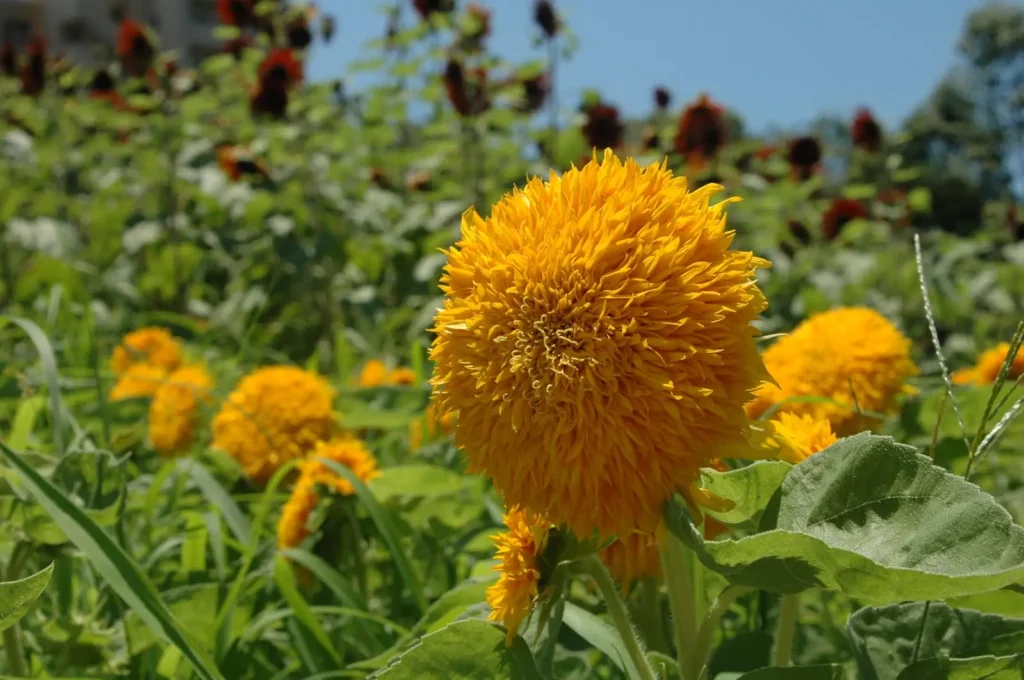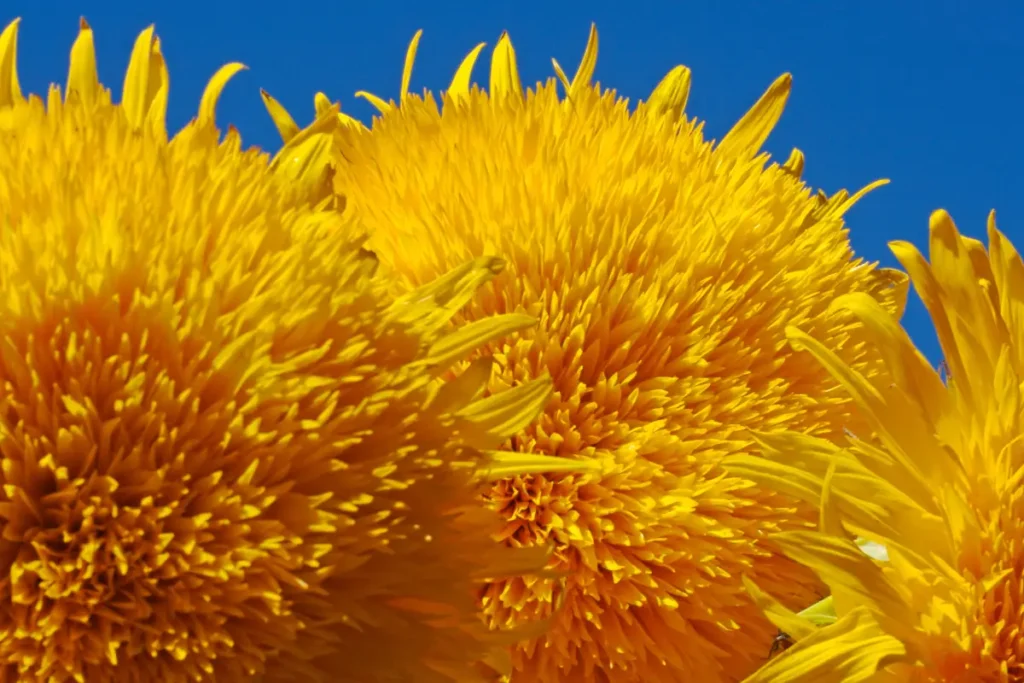Teddy Bear Sunflowers, renowned for their plush, golden blooms, are a delightful variant of the classic sunflower, bringing joy and vibrancy to any garden.
These compact, bushy plants typically grow to a height of 2-3 feet, making them a versatile choice for gardeners with space constraints or those seeking variety.
Their fluffy, radiant blooms, resembling the fur of a teddy bear, have made them a popular choice among flower enthusiasts and gardeners alike. Growing Teddy Bear Sunflowers requires a nuanced understanding of their characteristics and needs.
In this article, I will tell you how to grow Teddy Bear Sunflowers and share the ideal conditions for their growth. I’ll also provide a comprehensive guide on nurturing these charming flowers to full bloom, ensuring a garden filled with golden, fluffy joy.

Understanding Teddy Bear Sunflowers
Teddy Bear Sunflowers, scientifically known as Helianthus annuus, are distinguished by their dense, golden-yellow petals and relatively small size. They typically reach heights between 18 to 36 inches, with blooms measuring approximately 4 to 6 inches across. The lush, multi-petaled blooms give them a fluffy appearance, reminiscent of a teddy bear’s fur, hence the name.

These sunflowers are annual plants, completing their life cycle in one growing season. They are known for their hardiness and resilience, making them suitable for gardeners of all experience levels. The vibrant, cheerful blooms of Teddy Bear Sunflowers are not only aesthetically pleasing but also serve as a rich source of nectar for pollinators, enhancing biodiversity in the garden.
Ideal Conditions for Growth
To thrive, Teddy Bear Sunflowers prefer full sun exposure, requiring at least six hours of direct sunlight daily. They are adaptable to a range of soil types. However, they flourish best in well-drained, nutrient-rich soil with a pH level between 6.0 and 7.5. Regular watering is essential, particularly during dry spells. Care should be taken to avoid waterlogged conditions as this can lead to root rot.
These sunflowers are warm-season plants. It is best to sow the seeds after the last frost of spring when the soil has adequately warmed.
While Teddy Bear Sunflowers are relatively low-maintenance, they benefit from a balanced fertilizer applied at the time of planting to support healthy growth and abundant blooming. Regular monitoring for pests and diseases, such as aphids and mildew, will ensure the longevity and vibrancy of the plants.
Step-by-Step Guide to Planting Teddy Bear Sunflowers
Cultivating Teddy Bear Sunflowers can be a rewarding experience. With the right approach, these golden blooms can be a delightful addition to your garden.
Choosing the Right Time and Place
Selecting the appropriate time and location is crucial for growing healthy Teddy Bear Sunflowers. These sunflowers thrive in warm conditions, so it’s best to plant them after the last frost, typically between late spring and early summer, when the soil temperature is above 50°F (10°C).
Choose a location that receives at least six hours of direct sunlight daily, as sunflowers are heliotropic and will grow towards the light. A well-drained, fertile soil is ideal, with a pH level between 6.0 and 7.5. Consider conducting a soil test to determine soil fertility and amend it with organic matter or fertilizer if necessary.
Bonus Hack: Planting sunflowers near a wall or a fence can provide them with support as they grow, preventing them from bending or breaking due to wind or their own weight.
Processo di semina
Once the right time and place are determined, start by preparing the soil, removing weeds, and loosening it to a depth of about 12 inches. Sow the Teddy Bear Sunflower seeds at a depth of 1 to 2 inches. Space them about 6 inches apart to allow ample room for growth.
Water the seeds gently but thoroughly. Keep the soil consistently moist until the seeds germinate, usually within 7 to 10 days. Once the seedlings are about 3 inches tall, thin them to a spacing of about 18 to 24 inches apart.
Teddy Bear Sunflowers have moderate nutrient requirements. Apply a balanced, slow-release fertilizer at the time of planting. Avoid high-nitrogen fertilizers, as they can lead to excessive foliage at the expense of blooms.
Mulching around the base of the sunflowers can help retain soil moisture, suppress weeds, and regulate soil temperature, promoting healthy growth.

Additional Tips and Hacks
- Regular Watering: Consistent watering is vital, especially during dry periods. However, avoid over watering as it can lead to root rot. Water deeply and infrequently, allowing the soil to dry out between waterings.
- Staking: Although Teddy Bear Sunflowers are shorter than other varieties, staking can provide additional support, especially in windy conditions. Use soft ties to secure the stem to the stake, allowing some movement.
- Monitoring and Pruning: Regularly check the plants for signs of pests and diseases, such as aphids and mildew, and treat them promptly. Remove damaged or diseased leaves and spent flowers to encourage new blooms and maintain plant health. See also: Piante da compagnia di girasole
Cura e manutenzione continua
Stick to the following guidelines and recommendations to ensure the sustained health of your Teddy Bear Sunflowers.
- Aim to water the plants early in the morning, allowing the soil to dry out between waterings, to a depth of about 6 to 8 inches. Overwatering can lead to root rot, so it’s essential to maintain a balance.
- Teddy Bear Sunflowers benefit from a balanced fertilizer applied at the time of planting. However, excessive nitrogen can lead to lush foliage and fewer blooms, so choose a fertilizer with a balanced N-P-K ratio or one with higher phosphorus and potassium. A mid-season application of a low-nitrogen fertilizer can support blooming and overall plant health.
- Teddy Bear Sunflowers, like other varieties, are susceptible to pests and diseases. Aphids, acari di ragno, and snails are common pests that can affect these sunflowers. Regular inspection and prompt intervention are key. Insecticidal soaps or olio di neem can effectively control aphids and mites, while snail baits can manage snail infestations.
- Diseases such as downy mildew, rust, and powdery mildew can also afflict Teddy Bear Sunflowers. These are often due to excessive moisture on the foliage or poor air circulation. To manage these diseases, avoid overhead watering, space the plants adequately, and remove affected leaves promptly. Fungicides can be used as a last resort for severe infections.
Fertilizzanti consigliati
| Immagine | Titolo | Primo | Acquistare |
|---|---|---|---|
 | Fertilizzante solubile in acqua Southern Ag PowerPak 20-20-20 con micronutrienti (5 LB) | PrimoIdoneo | Controlla il prezzo su Amazon |
 | JR Peters 52024 Jacks Classic No.1.5 20-20-20 Fertilizzante per tutti gli usi | PrimoIdoneo | Controlla il prezzo su Amazon |
Superiore | Schultz SPF70690 5# Alimento vegetale solubile in acqua per tutti gli usi 20-20-20 | PrimoIdoneo | Controlla il prezzo su Amazon |
 | Fertilizzante EZ-gro 20 20 20 - Alimento liquido per piante per tutti gli usi - Il modo migliore per coltivare piante verdi - Nutrienti miracolosi per la coltivazione in giardino - 1 Qt | PrimoIdoneo | Controlla il prezzo su Amazon |
 | Fertilome 11722 Alimento per piante solubile in acqua per tutti gli usi 20-20-20 - 3 libbre. | PrimoIdoneo | Controlla il prezzo su Amazon |
 | Peter's Professional 20-20-20 Fertilizzante solubile in acqua per uso generico con micronutrienti. (1 sterlina) | Primo | Controlla il prezzo su Amazon |
 | Fertilome (11721) Alimento vegetale solubile in acqua per tutti gli usi 20-20-20 (1,5 lb.) | PrimoIdoneo | Controlla il prezzo su Amazon |
 | Fitleaf Leaf Vitality Multiuso 20-20-20 (3,52 oz) – Fertilizzante idrosolubile per mangime fogliare di alta qualità da spruzzare per tutte le piante – Promuove la crescita della biomassa e il colore vivace delle foglie, nutrimento completo delle piante con aminoacidi | Primo | Controlla il prezzo su Amazon |
Harvesting and Enjoying Teddy Bear Sunflowers
Typically, this plant is ready when the petals have unfolded and the back of the head turns brown. To harvest, cut the stem about one foot below the flower head during the morning hours when they are fully hydrated. Use sharp, clean scissors or pruners to avoid damaging the plant.
Once harvested, Teddy Bear Sunflowers can be used in various ways. Their vibrant, fluffy blooms make stunning vase arrangements and garden displays. Additionally, they can be positioned to attract wildlife; their nectar and pollen draw bees, and their seeds are a favorite among birds.
Final Thoughts on Teddy Bear Sunflowers
Growing Teddy Bear Sunflowers involves understanding their characteristics, providing optimal growing conditions, regular care, and timely harvesting. By following the stepwise method I’ve mentioned above, you can cultivate these radiant, fluffy blooms successfully, adding a golden charm to your garden. Embrace the joy of gardening by growing Teddy Bear Sunflowers and revel in the beauty and vibrancy they bring to your outdoor space.
Ti piace questo articolo? Potrebbe interessarti anche… How To Plant Sunflower Seeds in Pots

Darrell ha una passione per il giardinaggio che ha ereditato da suo padre. Andare Qui per saperne di più sull'influenza che suo padre ha avuto nel suo amore per il giardinaggio. Se vuoi inviare un messaggio veloce a Darrell, allora visita la sua pagina di contatto qui.

![Come innaffiare le piante d'appartamento [Cura delle piante 101]](https://wraxly.com/wp-content/uploads/2021/03/How-to-Water-Indoor-Plants-Plant-Care-101-1200-1024x576.webp)

![Piante in crescita da talee [Una semplice guida]](https://wraxly.com/wp-content/uploads/2021/03/Growing-Plants-from-Cuttings-A-Simple-Guide-1200-1024x576.webp)